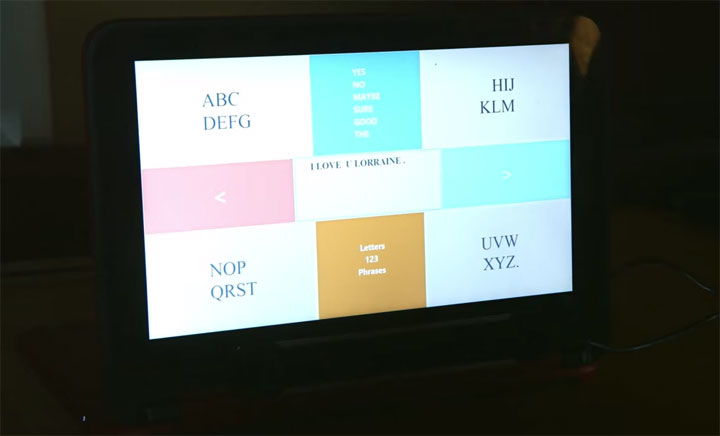TORONTO – Valentine’s Day will be extra special for Don Moir and his family this year – the London, Ont., man will finally be able to tell his wife he loves her after 15 years of non-verbal communication.

Moir, who suffers from ALS, breathes through a ventilator and isn’t able to speak.
But thanks to Not Impossible, an innovative tech lab, Moir has been equipped with specialized software that allows him to communicate.
Amyotrophic lateral sclerosis – commonly known as ALS or Lou Gehrig’s disease – is a non-contagious muscular disease that cause the “living wires” that connect a person’s brain to their muscles to degenerate — leading to a loss of mobility, changes or complete loss of speech, and eventually the ability to breathe.
Moir was fitted with a ventilator to help him breath in 1999. Until now, he has been communicating using a letter board – a sheet of paper with the alphabet divided into quarters. He would spell out words letter by letter by glancing at the various quadrants.
Javed Gangjee, an engineer and volunteer with Not Impossible labs, developed a similar interface that replicated Moir’s letter board in a digital form.
“The goal of the device was to create something actually allowed Don to speak audibly with his family and be able to communicate more independently,” said Gangjee in a video released Wednesday.
However, the team had a big challenge – Moir had never used a computer. Moir was diagnosed in 1995 and never learned how to use one.
“He missed that whole era of really accessible personal computers and cellphones,” said Not Impossible founder Mick Ebeling in the video.
So Gangjee designed the software to be as simple as possible. The program detects Moir’s eye movements and guesses word combinations based on what quadrants he is looking at. Once the program forms the right word, he looks at the centre of the screen to select it.
According to the video, Moir can now type over 2.5 words per minute. Once he gets up to three or four words per minute, he will be typing at full conversational speed.
Technology is making strides in accessibility
Not Impossible labs has been working since 2013 to create tech solutions for people with accessibility issues. In the past, the group’s volunteers have created 3D-printed prosthetic arms for children in war-torn Sudan and a gadget dubbed the “Eyewriter” to allow individuals with paralysis to communicate.
Many other inventors are using technology to better people’s lives.
This month a new device called eSight made headlines for allowing a legally blind woman to see her newborn baby for the first time.
READ MORE: Legally blind mom sees baby boy thanks to new technology
The device is equipped with a video camera that sits on the bridge of the person’s nose. Images are captured by the camera which enhances the picture that is projected onto high definition screens in front of the person’s eyes.
It allows the person wearing the device to see details they never could have before.
Researchers at the University of Toronto have also been working to ease the process of fitting and making prosthetic limbs for children with disabilities in Uganda using consumer grade 3D printers.
“We’re seeing if we can capture a 3D model of a child’s residual limb – whatever they have left after an amputation – turn that model into a 3D model and convert that into a printable socket that can serve to support a prosthetic limb,” researchers told Global News last year.
Some developers are even helping animals.
Buttercup the duck, who was born with a backwards foot, was designed a 3D-printed silicon foot that allowed him to walk and swim for the first time back in 2013.





Comments